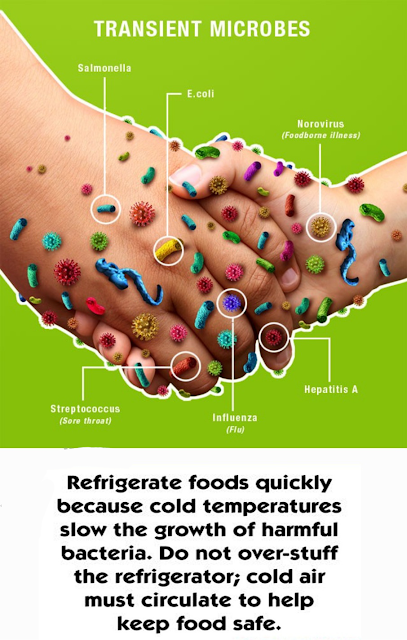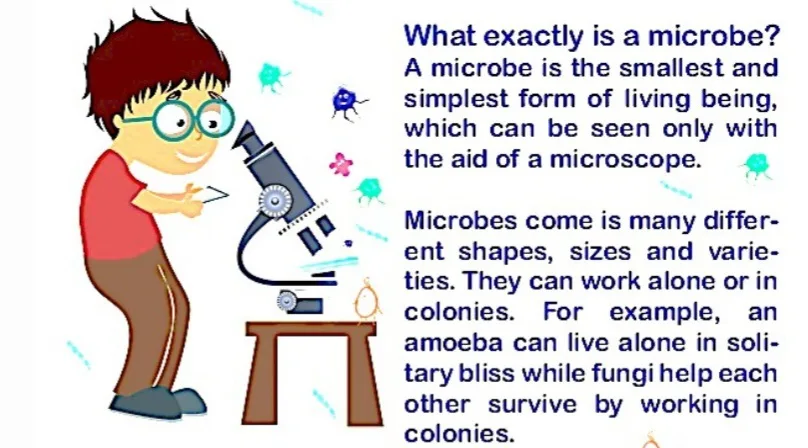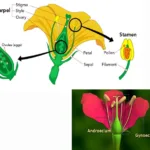MICROBES IN HUMAN WELFARE

•Microbes have great diversity
o protozoa,
o bacteria,
o fungi and
o microscopic plant
o viruses
o viroids (infective ssRNA)
o prions (proteinaceous infectious agents)
MICROBES IN HOUSEHOLD PRODUCTS:
●LAB (LACTIC ACID BACTERIA):
•Grow in milk and convert it to curd.
•During growth, the LAB produces acids
•that coagulate and partially digest the milk proteins.
•Inoculum/starter (small amount of curd) is added in fresh milk which convert milk into curd
IMPROVES ITS NUTRITIONAL QUALITY BY INCREASING VITAMIN B12.
The LAB plays very beneficial role in checking disease causing microbes in our stomach.
● LEUCONOSTOC MESENTEROIDES
• Fermentation of dough, which is used for making foods such as dosa and idli
• The puffed-up appearance of dough is due to the production of CO2 gas.
• Fermentation is incomplete oxidation of glucose under anaerobic condition.
• BREAD DOUGH IS FERMENTED BY BAKER’S YEAST (SACCHAROMYCES CEREVISIAE).
• ‘Toddy’, a traditional drink of some parts of southern India is made by fermenting sap from palms.
• Microbes are also used to ferment fish, soybean and bamboo shoots to make foods.
• CHEESE
o Different varieties of cheese are known by their characteristic TEXTURE, FLAVOUR AND TASTE, the specificity coming from the microbes used.
o The large holes in ‘Swiss cheese’ are due to production of a large amount of CO2 by a bacterium named Propionibacterium sharmanii.
o The ‘Roquefort cheese’ are ripened by growing a specific fungus (penicillium rouqforti) on them, which gives them a particular flavour.
o Streptococcus lactis is also used in this process.
o The Roquefort cheese is sheep milk cheese.

MICROBES IN INDUSTRIAL PRODUCTS:
• FERMENTED BEVERAGES:
o Microbes especially yeasts (saccharomyces cerevisae-Brewer yeast) have been used for the production of beverages like wine, beer, whisky, brandy or rum.
o Brewer’s yeast for fermenting malted cereals & fruit juices, to produce ethanol.
o Depending on the type of the raw material used for fermentation and the type of processing (with or without distillation) different types of alcoholic drinks are obtained.
o Wine and beer are produced without distillation.
o Whisky, brandy and rum are produced by distillation of the fermented broth.
• ANTIBIOTICS:
o Best example of biological antagonism
o chemical substances
o produced by some microbes
o can kill or retard the growth of other (disease-causing) microbes.
o Penicillin was the first antibiotic
discovery by ALEXANDER FLEMING
during study of Staphylococci –>chemical from Penicillium notatum (fungi) did not allow the growth of bacteria.
He named this chemical as Penicillin.
Penicillin full potential as an effective antibiotic was established much later by ERNEST CHAIN AND HOWARD FLOREY.
FLEMING, CHAIN AND FLOREY WERE AWARDED THE NOBEL PRIZE IN 1945, FOR THIS DISCOVERY.
o Antibiotics have greatly improved our capacity to treat deadly diseases such as plague, whooping cough (kali khansi), diphtheria (gal ghotu) and leprosy (kusht rog).


CHEMICALS, ENZYMES AND OTHER BIOACTIVE MOLECULES
• Microbes used for commercial and industrial production of certain
chemicals like organic acids, alcohols and enzymes.
• FUNGI ASPERGILLUS NIGER –> citric acid producer.
• ACETOBACTER ACETI (A BACTERIUM) –>acetic acid production
• CLOSTRIDIUM BUTYLICUM (A BACTERIU M) –>butyric acid production
• LACTOBACILLUS (A BACTERIUM) –>Lactic acid production
• YEAST (SACCHAROMYCES CEREVISIAE) –> production of ethanol.
• Microbes are also used for production of enzymes.
• Lipases
o used in detergent formulations and are helpful in removing oily stains in laundry.
• STREPTOKINASE
o Produced by the bacterium Streptococcus and modified by genetic engineering
o Used as a ‘clot buster’ for removing clots from the blood vessels of patients who have undergone myocardial infection leading to heart attack.
• PECTINASE AND PROTEASE Used in clarifying the fruit juice during commercial production.
• CYCLOSPORIN A (A BIOACTIVE MOLECULE)
o used as an immunosuppressive agent in organ-transplant patients.
o It is produced by the fungus Trichoderma polysporum.
• STATINS
o Produced by the yeast Monascus purpureus
o Used as blood-cholesterol lowering agents.
o It acts by competitively inhibiting the enzyme responsible for synthesis of cholesterol.
MICROBES IN SEWAGE TREATMENT
• THE MUNICIPAL WASTE WATER –> SEWAGE.
o It contains large amounts of organic matter and microbes.
o Many of which are pathogenic.
o MAIN COMPONENT OF SEWAGE IS HUMAN EXCRETA.
• This cannot be discharged into natural water bodies like rivers and streams directly because they create water pollution.
• Therefore, before disposal sewage is treated in SEWAGE TREATMENT PLANTS (STPS)
to make it less polluting.
• TREATMENT OF WASTE WATER IS DONE BY THE HETEROTROPHIC MICROBES NATURALLY PRESENT IN THE SEWAGE.
• This treatment is carried out in two stages:
o primary treatment and
o secondary treatment.
• PRIMARY TREATMENT:
o It involves physical process like filtration and sedimentation.
o It is removal of floating debris by sequential filtration.
o After filtration grit (small particles of stones and sand) are removed by sedimentation.
o All the solid settled from sewage form PRIMARY SLUDGE.
o After removal of floating debris and grit from sewage, supernatant (liquid above the sediments) is called EFFULENT.
o The effluent from the primary settling tank is taken for secondary treatment.
• SECONDARY TREATMENT:
o SECONDARY TREATMENT involves microorganisms.
o The primary effluent is passed into large aeration tanks where it is constantly agitated mechanically and air is pumped into it.
o This allows vigorous growth of useful AEROBIC MICROBES INTO FLOCS.
o FLOCS IS MASSES OF BACTERIA ASSOCIATED WITH FUNGAL FILAMENTS TO FORM MESH LIKE STRUCTURES.
o While growing, these microbes consume the major part of the organic matter in the effluent.
o This significantly reduces the BOD (biochemical oxygen demand) of the effluent.
o BOD refers to the amount of the oxygen that would be consumed if all the organic matter in one litre of water were oxidised by bacteria.
o BOD is a measure of the organic matter present in the water.
o If a water body has more BOD means it has more organic matter in it that is more pollutant it has.
o In first stage of secondary treatment aerobic microbes are involved.
o Once the BOD of sewage or waste water is reduced significantly, the effluent is then passed into a settling tank where the bacterial ‘flocs’ are allowed to sediment.
o This sediment is called ACTIVATED SLUDGE.
o A small part of the activated sludge is pumped back into the aeration tank to serve as the inoculum.
o Inoculum is used in growth of flocs in primary effulent.
o The remaining major part of the activated sludge is pumped into large tanks called ANAEROBIC SLUDGE DIGESTERS.
o Anaerobic sludge digester has anaerobic bacteria which digest the bacteria and the fungi present in the activated sludge.
o During this digestion, bacteria produce a mixture of gases such as methane, hydrogen sulphide and carbon dioxide.
o These gases form biogas and can be used as source of energy as it is inflammable.
o The effluent from the secondary treatment plant is generally released into natural water bodies like rivers and streams.
• The Ministry of Environment and Forests has initiated Ganga Action Plan and Yamuna Action Plan to save these major rivers of our country from pollution.
o Under these plans, it is proposed to build a large number of sewage treatment plants
o only treated sewage may be discharged in the rivers.
MICROBES IN PRODUCTION OF BIOGAS:
• Biogas is a mixture of gases (mainly methane) produced by the microbial activity and which may be used as fuel.
• Methanogen bacteria are present in the rumen (a part of stomach) of cattle.
• A lot of cellulosic material present in the food of cattle is also present in the rumen.
• In rumen, these bacteria help in the breakdown of cellulose and play an important role in the nutrition of cattle.
• THE EXCRETA (DUNG) OF CATTLE, COMMONLY CALLED GOBAR, IS RICH IN METHANOGEN BACTERIA. DUNG CAN BE USED FOR GENERATION OF BIOGAS, COMMONLY CALLED GOBAR GAS.
• Biogas plants are more often built in rural areas. The biogas thus produced is used for
cooking and lighting.
• The technology of biogas production was developed in India mainly due to the efforts of INDIAN AGRICULTURAL RESEARCH INSTITUTE (IARI) and KHADI AND VILLAGE INDUSTRIES COMMISSION (KVIC).
MICROBES AS BIOCONTROL AGENTS:
• BIOCONTROL use of biological methods for controlling plant diseases and pests.
• Biocontrol agent
• control the plant disease and pest
• also save the environment and organisms
• from toxicity of insecticides and pesticides.
• BIOCONTROL AGENTS ARE USED MAINLY IN ORGANIC FARMING.
• These agents only eradicate pest whereas chemical pesticides and insecticides indiscriminately kill the predator, pest etc.
• Sustainability of a landscape is depending upon diversity and biocontrol agents favour the diversity.
• THE LADYBUG (BEETLE WITH RED AND BLACK MARKING) ARE USEFUL TO GET RID OF APHIDS.
• DRAGONFLY ARE USEFUL TO GET RID OF MOSQUITOES.
• BACILLUS THURINGIENSIS(BT)
• available in sachets as dried spores
• In the gut of the larvae, the toxin is released and the larvae get killed.
• The bacteria will kill the caterpillars but leave other insects unharmed (only caterpillar damage the plant).
• FUNGUS TRICHODERMA SPECIES free-living fungi that are very common in the root ecosystems. They are effective biocontrol agents of several plant pathogens.
• BACULOVIRUSES
o pathogens that attack insects and other arthropods.
o The majority of baculoviruses used as biological control agents are in the genus Nucleopolyhedrovirus.
o These viruses are excellent candidates for species-specific, narrow spectrum insecticidal applications.
o These viruses have no negative impacts on plants, mammals, birds, fish or even on non-target insects.
• This Is Especially Desirable When Beneficial Insects Are Being Conserved To Aid In An Overall Integrated Pest Management (Ipm) Programme, Or When An Ecologically Sensitive Area Is Being Treated.
MICROBES AS BIOFERTILISERS
• The overuse of chemical fertiliser –> environment pollution
• Switch to organic farming –> the use of bio fertilisers.
• BIO FERTILISERS ARE ORGANISMS–>ENRICH THE NUTRIENT QUALITY OF THE SOIL.
• The main sources of biofertilizers are bacteria, fungi and cyanobacteria.
• BACTERIA RHIZOBIUM is present in root nodules of leguminous plant and have symbiotic relation with plant. These bacteria fix atmospheric nitrogen into organic forms, which is used by the plant as nutrient.
• AZOSPIRILLUM AND AZOTOBACTER are free living atmospheric nitrogen fixing
bacteria present in soil.
• MYCORRHIZA is association of fungi with roots of higher plants.
• MANY MEMBERS OF THE GENUS GLOMUS FORM MYCORRHIZA.
• The fungal symbiont in these associations absorbs phosphorus from soil and passes it to the plant.
• Plants having mycorrhiza show resistance to root-borne pathogens, tolerance to salinity and drought, and an overall increase in plant growth and development.
• Anabaena, Nostoc, Oscillatoria, etc. are cyanobacteria can fix N2. They are widely distributed in aquatic and terrestrial ecosystem.
• Cyanobacteria are autotrophic.
• IN PADDY FIELDS, CYANOBACTERIA SERVE AS AN IMPORTANT BIOFERTILIZER.
• Cyanobacteria (Blue green algae) also add organic matter to the soil and increase its fertility.
MICROBES IN HUMAN WELFARE



